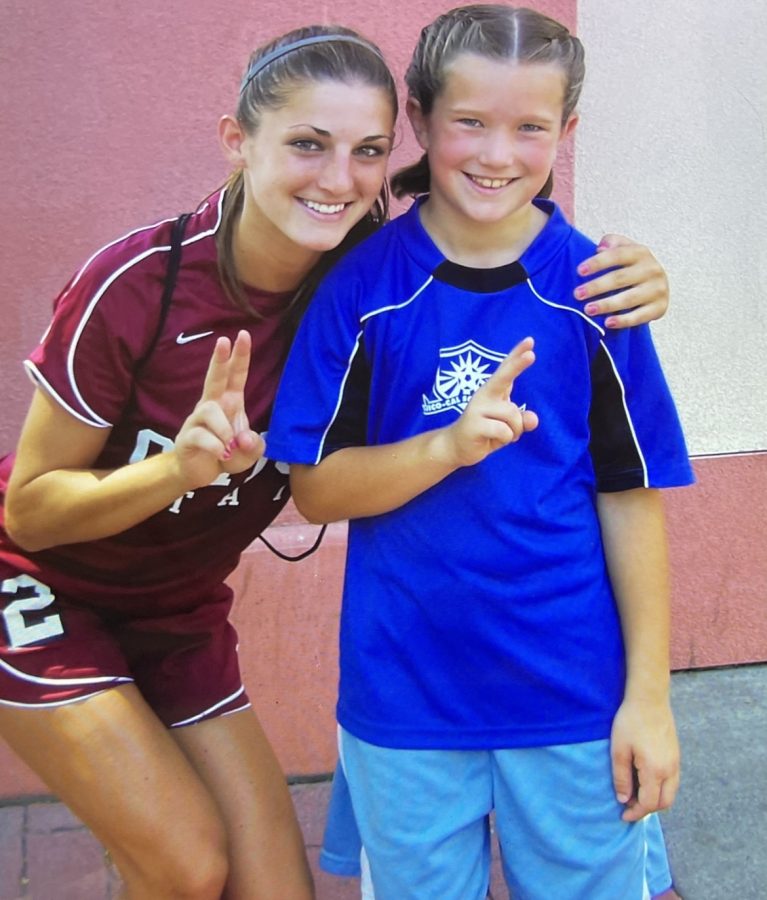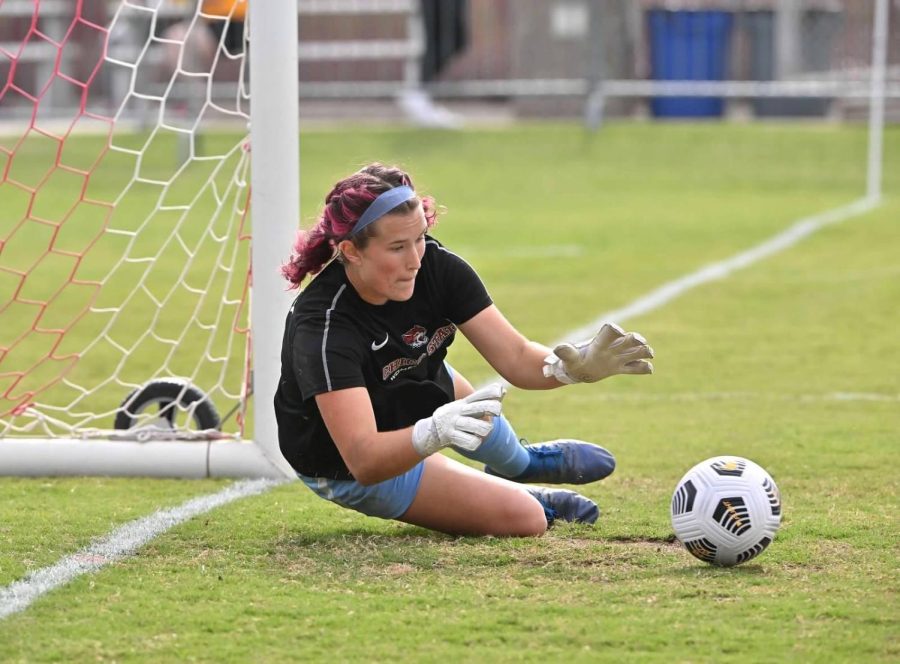It hadn’t even been an hour since the game, and I was already in the bathroom, ripping a pair of serrated scissors across my skin.
I had just left the field with my teammates, smiling and dancing to the post-game music. As soon as I turned to walk home alone and my face was away from the cheering crowd, my mask dropped faster than the blood would from my wrists.
There are two sides to athletics, but only one is broadcasted.
We are all familiar with the image of smiling athletes, pumped full of adrenaline, exchanging high fives with their teammates as they play the game they love. But there’s a darker side that is only experienced by the athletes, like hyperventilating in the bathroom after practice or gnawing their fingernails raw trying to finish a paper at 3 a.m., which was the only time they had to write it.
The mental health aspect of athletics goes unspoken and unknown.
“Approximately 30% of women and 25% of men who are student-athletes report having anxiety,” according to the American College of Sports Medicine. “And only 10% of all college athletes with known mental health conditions seek care from a mental health professional.”
College athletics is a huge commitment. It is common for athletes to have two to five hours of training six days a week throughout the semester. In addition, there are often required team meetings, film sessions and other weekly off-field work.
For competitions, it is common for athletes to miss up to a third of in person classes during their season. All of this comes with the expectation that athletes will keep a high enough GPA to maintain scholarships and eligibility.
“The onset of my mental health problems came from college athletics,” a female athlete for Chico State said. “That’s because of coaches, the stress of it all and the lack of breaks.”
This commitment itself is anxiety inducing, but even more, athletes are often very emotionally invested in their sports and in their athletic performance, which can be mentally taxing.
I’ve played soccer since I was four-years-old and what started as a game became so much more to me. Since middle school, I had begun to make bigger sacrifices to climb the ladder of competition. Most of my high school experience was spent traveling four hours a day after school to get to quality training in another city.
Soccer became what drove me. It wasn’t just a sport; it was my purpose, and even more, it was a love that was always accessible. No matter what was happening outside of soccer, no matter what relationships left me, soccer was always there. It was my outlet and a physical form of love.
During the senior year of my college soccer season, a lot of my anxiety stemmed from the feeling that I needed to be perfect to be seen. There were already established key players, and unfortunately for me, I was up against one of them, and as a goalkeeper, only one of us would get to play.
I had so much time and passion invested in the game. I wanted the starting position with every fiber of my soul. I had poured everything I could into earning the position and invested hundreds of extra hours of training.
The most devastating part was that being chosen for playing time was entirely out of my control.
College athletics are extremely business-oriented. For the institution, and sometimes for coaches, athletics are a source of recognition. This clout comes with winning and with successful programs. Therefore, winning and stats are what matter the most, because a losing team isn’t as recognized.
What I see as my passion, they see as monetary and personal opportunity for the program.
In some cases, coaches disregard player mental health because of their tunnel-vision toward victory.
“There’s no way coaches understand the pressure that they put on us and the performance anxiety we experience,” a Chico State athlete said. “They have no idea.”
There was one day in the middle of season that I had a panic attack before practice, causing me to be 15 minutes late to training. This was the only time in three years of being on the team that I had ever been late. I was told in a meeting with the coaches the next day that my “meltdown” the previous day was part of why they questioned my reliability as a player.
I was nauseous before every practice after that because I felt I could not show any form of anxiety, or it would be held against me in playing time decisions. Not only did my performance have to be perfect, but my emotions did too.
Here’s the problem:
We do not recognize the validity of student athlete mental health struggles, or as something that should be addressed.
According to an NCAA student-athlete well-being study published in May 2022, “When asked whether they thought their mental health was a priority to their athletics department, 55% of men’s sports participants and 47% of women’s sports student-athletes agreed or strongly agreed.”
The disregard for athlete mental health is not only a problem within the staff, but also within the lack of institutional resources for athletes.
Athletic programs are required to have athletic trainers who help athletes handle physical injuries. Sports psychologists are frequently present in larger Division I programs to assist athletes with their mental health. However, Division II and III schools have started cutting resources due to funding, and mental health is the first to go.
Mental health resources for athletes are viewed as nonessential.
We cannot take strides toward solving this until it is first recognized as a problem that needs solving.
My college career ended and I never got to play my senior year.
Soccer had always been my outlet and I felt that I was grieving a physical love with the realization that I would never touch a college field again.
I think it was the lack of control felt and the need for release that made me grab the scissors.
I am not the only athlete who has mental health struggles. Though, I am one of few who is willing to lay my scars in the public eye with the hope that someone will care enough to protect college athletes moving forward.

The last day I had with my team I couldn’t stop crying. My emotions had nothing to do with my soccer career. I cried because I knew how hard the journey ahead was for my younger teammates and that I couldn’t be there with them anymore to help them.
I recently saw a picture of myself when I was 10-years-old as a ball girl at a Chico State soccer game. I was posing with jersey number two, which was my number at the time. I remember feeling like she was a celebrity, and the coolest person I had ever seen. I grew up to be her, only with the number zero on my jersey instead.
Protect the athletes and the 10-year-olds who grow up to wear the jersey. I don’t want them to have scars like mine.
Resources:
- Athletes Against Anxiety and Depression offers free mental health support through therapy, manuals and guided videos.
- 988 Lifeline offers free confidential support 24/7 in moments of crisis and distress.
- Recognize to Recover contains a detailed list of sports specific mental health concerns, and offers specific resources and support to each.
Hunter Casperson is a dual-sport athlete at Chico State and can be reached at orionmanagingeditor@email.com









David Bunganich // Dec 18, 2022 at 12:43 pm
A courageous article written by a brave young woman. The world needs more people like her.
JT // Dec 11, 2022 at 8:40 pm
I too was a college athlete and as I finished reading this article, I find myself in tears I haven’t shed since the week I quit my sport for mental health reasons. I was always told to suppress emotions in exchange for showing strength and stoicism on the field and even more, on the sideline. This article speaks to me more than anything I’ve read before. As the older sibling of a Chico State athlete, this article reminds me of the three plus grueling years I had to watch my sibling struggle through the same anxiety-ridden path that I knew so well. I hurt that they could not escape my fate, I hurt that younger players will continue to go through the cycle of learning to hate the sport they once loved, and I selfishly hurt that I will not get those four years of my life back. Thank you, Hunter, for speaking and sharing your experience of those that have been living in the shadows.
Michael // Nov 12, 2022 at 6:31 pm
I have had the pleasure of knowing this fine young woman since she was that 10 year old soccer teammate of my daughter, through now. Not only is she a fantastic player, but she’s a fantastic teammate and human. And in true Hunter Casperson fashion, she has taken her experience and pain, and put it out there courageously so that others may benefit. Thank you for sharing Hunter, and let’s hope those that NEED to here this will, and do something about it.